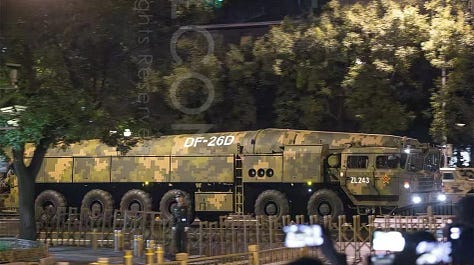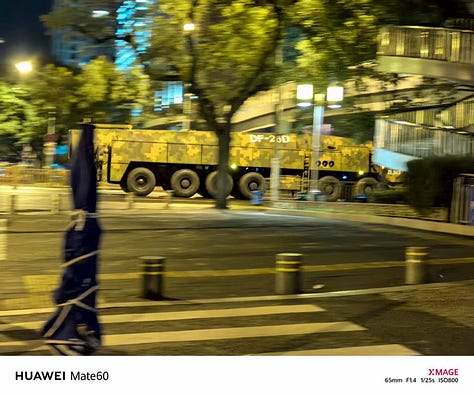Note: The following text was originally posted on my X/Twitter account.
The forthcoming military parade in Beijing will amount to the formal unveiling of the DF-26D, which appears to be a specific version of the reportedly "modular" DF-26 ballistic missile family that China unveiled at a military parade on 3 September 2015.



While details about the DF-26D are not public knowledge as of this writing, the designation naturally raises questions about the nature of the DF-26A, DF-26B, and DF-26C. The latest edition of the U.S. Department of Defense's annual "China Military Power Report," which was released in December 2024, included a table that made a distinction between the CSS-18 Mod 1, CSS-18 Mod 2, and CSS-18 Mod 3. Open-source analyses have surmised that these refer to a DF-26A, DF-26B, and DF-26C—CSS-18 is the American military's designation for the Chinese DF-26. The presence of a ballistic missile (mockup) at a parade rehearsal in Beijing with the DF-26D designation indicates the existence of a fourth DF-26 variant, which will presumably have the internal American designation CSS-18 Mod 4. It is important to note that the 2024 edition of the "China Military Power Report" was outdated at the time of publication by design, that it is an intrinsically political document that makes very deliberate disclosures to serve political ends, and that no edition of the unclassified report is likely to have ever reflected the full scope of the United States' understanding of China's military capabilties. There is, as such, no reason to assume that the unveiling of the DF-26D has caught the U.S. government by surprise.
While it was publicly unveiled a decade ago, much about the DF-26 remains beyond the realm of public knowledge. The DF-26 has long been reported to employ a wheeled launcher and ballistic missile design that allows PLA Rocket Force (PLARF) launch crews to independently—without having to travel to a suitably equipped facility—and "quickly" swap warheads in the field. While the reported ability to swap "conventional" high explosive warheads for nuclear warheads and vice versa has long dominated discussions about the DF-26, it is important to recognize that this reported design feature will also allow PLARF launch crews to swap different types of "conventional" high explosive warheads so that a DF-26 ballistic missile loaded onto a launcher cna be "quickly" prepared for use against a given target type.
In addition to its regional nuclear strike role, in which it supplants the DF-21A and complements China's fast-expanding force of so-called intercontinental range ballistic missiles, the DF-26 is notably also associated with the maritime strike role. That is, the DF-26—or at least DF-26 ballistic missiles equipped with a certain reentry vehicle and/or warhead—is also an anti-ship ballistic missile that succeeds the DF-21D (CSS-5 Mod 5). It is possible, even likely, that one of the DF-26 variants identified in the 2024 edition of the "China Military Power Report" refers to a specially configured anti-ship ballistic missile version. It is also important to note that there is no indication that China has deployed or intends to deploy a nuclear-armed anti-ship ballistic missile—the PLA's approach to maritime strike capabilities against the aircraft carrier-centric U.S. Navy has so far not entailed the employment of nuclear weapons at sea in the manner that Soviet Union and, to a lesser degree, the United States pursued during the Cold War.
Uncertainties notwithstanding, the reportedly "modular" nature of the DF-26 ballistic missile design and the reported ability of the associated wheeled launcher vehicles to use any member of the DF-26 ballistic missile family naturally raise questions as to what differentiates one variant of the DF-26 from another. If the ability to swap nuclear warheads with "conventional" high-explosive warheads is an inherent feature of the reportedly "modular" DF-26 design, there is no reason to use a different designation when a DF-26 ballistic missile is equipped with one swappable warhead or the other.
Concerning its use of an anti-ship ballistic missile, it is possible that there exists a specifically configured reentry vehicle that is optimized for use in a maritime strike role, even if other DF-26 variants may be of some utility in a maritime strike role. It is also possible that one of the known DF-26 variants refers to a specifically configured version that is intended to deliver submunitions (i.e., cluster munitions), a role that tends to require structural modifications to a munition in order to incorporate a release/dispensing mechanism that is not required when using a unitary "conventional" high explosive and/or unitary nuclear warhead. It is important to note that the DF-26 design family will be "limited" to the use of an airburst fuze/fuzing mode alongside a unitary high explosive vlast-fragmentation warhead against the likes of aircraft parked in the open at airbases if there is no DF-26 version/variant that is configured to release/dispense submunitions. This issue has major implications for military dynamics in the Western Pacific, including the survivability of American military aircraft based on the island of Guam and other airports/airbases situated some 3000 or so km from the Chinese coastline.
Uncertainties concerning the DF-26D notwithstanding, it is worth pointing out that PLARF has the option of adapting the DF-26 design—specifically its two solid rocket booster stages—toward a very different purpose. The South Korean Hyunmoo-5 (pictured below) ballistic missile offers an example of how it is possible to equip a ballistic missile design with what would ordinarily be characterized as a grossly oversized warhead at the cost of a very significant reduction in maximum range.
South Korea is understood to have developed the Hyunmoo-5 with the primary aim of employing it as a very short time-to-target heavy penetrating munition against hardened and deeply buried targets in North Korea. Unlike the United States, which can turn to its existing B-2 bombers—as it did in Operation Midnight Hammer against Iranian nuclear facilities in June 2025—and its forthcoming B-21 bombers to deliver heavy penetrating munitions such as the GBU-57 Massive Ordnance Penetrator (MOP), the PLA currently has very limited capabilities in this area. While the PLARF's DF-15 ballistic missile design family is reported to include a so-called bunker-busting version/variant that features a penetrating warhead, the DF-15 is a much smaller/lighter ballistic missile than the DF-26, and the DF-15's maximum range makes it primarily suitable for use against Taiwan. An adaptation of the DF-26's design for use as a heavy penetrating munition in the vein of the South Korean Hyunmoo-5 can significantly enhance the PLA's combat capabilities at a time when militaries worldwide are taking another look at hardening their most sensitive facilities and capability sets.
While there is currently nothing to suggest that the soon-to-be formally unveiled DF-26D features a design that has been optimized to penetrate deep and heavily buried targets, the very existence of yet another variant of the "modular" DF-26 ballistic missile draws attention to the versatility of this ballistic missile design family and the opportunities it affords the PLARF to further enhance China's strike capabilities.


